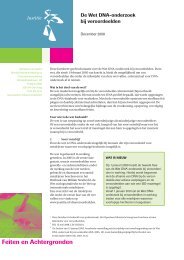INTERPOL HANDBOOK ON DNA DATA EXCHANGE AND PRACTICE
INTERPOL HANDBOOK ON DNA DATA EXCHANGE AND PRACTICE
INTERPOL HANDBOOK ON DNA DATA EXCHANGE AND PRACTICE
You also want an ePaper? Increase the reach of your titles
YUMPU automatically turns print PDFs into web optimized ePapers that Google loves.
•dna sampling kitsThis next section will outline the suggested contents of <strong>DNA</strong> sampling kits and how touse them. Care must be taken at all stages to avoid contamination and ensure that thesample collected is packaged and labelled correctly.Crime Scene Stain/<strong>DNA</strong> Sampling KitA scene of crime stain sampling kit contains at least the following items:• Documented check-list• Instructions on the use of the sampling kit• Breathable tamper-evident bags/containers and/or cardboard packaging, which havea unique number or barcode• Sterile (self wetting) swabs (extra swabs available if necessary)• Sample/vial of sterile water• Pair of disposable gloves• 1 x Form/label with relevant information about the sample (chain of custody)• The contents of a scene of crime sampling kit are to be used for collecting biologicalstains as previously statedProcedure for StainsLiquid SamplesIf blood, semen or saliva is present as a liquid or wet stain, it should be collected usingdry swabs or pipettes (if available). Sterile cotton wool swabs are suitable for collectingcrime scene samples. The sample should be collected on one area of the swab and notsmeared over the whole surface of the swab head.Dried StainsVisible stains can be collected in a number of ways. It is always preferable to recoveran item in its entirety. Where this is not possible stains can be recovered in a numberof ways:• Swabbing – moisten a swab with a very small amount of sterile water so that theswab is only moistened and not wet and use the swab to rub the <strong>DNA</strong> materialconcentrating the sample on as small an area as possible• Scraping – scrape the dried stain from the surface with a disposable sterile scalpelblade and place the flakes in a suitable sterile container or in clean folded paper.• Cutting – use a sharp sterile blade to cut out the surface bearing the <strong>DNA</strong> material,for example, wood and wallpaper.• Lifting – using adhesive tape the stain is lifted onto the sticky side of the tape which isthen placed sticky-side down onto a sterile surface such as an acetate sheet. This canmake a clean lift of the stain which is then preserved under the tape.In all circumstances, it may be relevant to also take a control sample.The person taking the sample must wear the gloves provided throughout the wholesampling procedure. Masks should be worn, especially if suffering from a cold or if closeexamination of the surface or stain is required.PAGE 24<strong>DNA</strong> SAMPLING<strong>AND</strong> EVIDENCE COLLECTI<strong>ON</strong>







